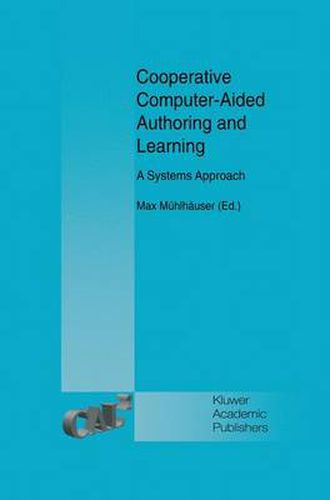Readings Newsletter
Become a Readings Member to make your shopping experience even easier.
Sign in or sign up for free!
You’re not far away from qualifying for FREE standard shipping within Australia
You’ve qualified for FREE standard shipping within Australia
The cart is loading…






This title is printed to order. This book may have been self-published. If so, we cannot guarantee the quality of the content. In the main most books will have gone through the editing process however some may not. We therefore suggest that you be aware of this before ordering this book. If in doubt check either the author or publisher’s details as we are unable to accept any returns unless they are faulty. Please contact us if you have any questions.
This text describes a practical system for computer assisted authoring and learning. Drawing from the experiences gained during the Nestor project, jointly run between the Universities of Karlsruhe, Kaiserslautern and Freiburg and the Digital Equipment Corp. Center for Research and Advanced Development, the book presents a concrete example of new concepts in the domain of computer-aided authoring and learning. The conceptual foundation is laid by a reference architecture for an integrated environment for authoring and learning. This overall architecture represents the nucleus, shell and common denominator for the R&D activities carried out. From its conception, the reference architecture was centered around three major issues: 1. Co-operation among and between authors and learners in an open, multimedia and distributed system as the most important attribute; 2. Authoring/learning as the central topic; 3. Laboratory as the term which evoked the most suitable association with the envisioned authoring/learning environment. Within this framework, the book covers four major topics which denote the most important technical domains, namely: 1. The system kernel, based on object orientation and hypermedia; 2. Distributed multimedia support; 3. Co-operation support, and 4. Reusable instructional design support. This text is a contribution to the emerging field of collaborative computing and should be essential reading for researchers and practitioners alike. Its pedagogic flavour also makes it suitable for use as a text for a course on the subject.
$9.00 standard shipping within Australia
FREE standard shipping within Australia for orders over $100.00
Express & International shipping calculated at checkout
This title is printed to order. This book may have been self-published. If so, we cannot guarantee the quality of the content. In the main most books will have gone through the editing process however some may not. We therefore suggest that you be aware of this before ordering this book. If in doubt check either the author or publisher’s details as we are unable to accept any returns unless they are faulty. Please contact us if you have any questions.
This text describes a practical system for computer assisted authoring and learning. Drawing from the experiences gained during the Nestor project, jointly run between the Universities of Karlsruhe, Kaiserslautern and Freiburg and the Digital Equipment Corp. Center for Research and Advanced Development, the book presents a concrete example of new concepts in the domain of computer-aided authoring and learning. The conceptual foundation is laid by a reference architecture for an integrated environment for authoring and learning. This overall architecture represents the nucleus, shell and common denominator for the R&D activities carried out. From its conception, the reference architecture was centered around three major issues: 1. Co-operation among and between authors and learners in an open, multimedia and distributed system as the most important attribute; 2. Authoring/learning as the central topic; 3. Laboratory as the term which evoked the most suitable association with the envisioned authoring/learning environment. Within this framework, the book covers four major topics which denote the most important technical domains, namely: 1. The system kernel, based on object orientation and hypermedia; 2. Distributed multimedia support; 3. Co-operation support, and 4. Reusable instructional design support. This text is a contribution to the emerging field of collaborative computing and should be essential reading for researchers and practitioners alike. Its pedagogic flavour also makes it suitable for use as a text for a course on the subject.